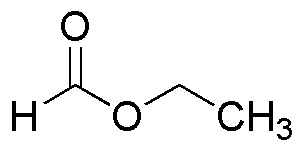Ethyl formate is widely utilized in research focused on:
- Flavoring Agent: Commonly used in the food industry, ethyl formate provides a fruity flavor to various products, enhancing the taste of candies, beverages, and baked goods.
- Solvent in Organic Synthesis: In laboratories, it serves as a solvent for organic reactions, facilitating the synthesis of various chemical compounds due to its favorable properties.
- Pesticide Formulation: Ethyl formate is employed in the agricultural sector as a fumigant and pesticide, effectively controlling pests while being less toxic to humans and the environment compared to other chemicals.
- Perfume and Fragrance Industry: Its pleasant aroma makes it a popular ingredient in perfumes and fragrances, allowing manufacturers to create appealing scents for personal care products.
- Biotechnology Applications: In biotechnological research, it is used as a reagent in the extraction and purification processes, aiding in the isolation of specific compounds from biological samples.
General Information
Properties
Safety and Regulations
Applications
Ethyl formate is widely utilized in research focused on:
- Flavoring Agent: Commonly used in the food industry, ethyl formate provides a fruity flavor to various products, enhancing the taste of candies, beverages, and baked goods.
- Solvent in Organic Synthesis: In laboratories, it serves as a solvent for organic reactions, facilitating the synthesis of various chemical compounds due to its favorable properties.
- Pesticide Formulation: Ethyl formate is employed in the agricultural sector as a fumigant and pesticide, effectively controlling pests while being less toxic to humans and the environment compared to other chemicals.
- Perfume and Fragrance Industry: Its pleasant aroma makes it a popular ingredient in perfumes and fragrances, allowing manufacturers to create appealing scents for personal care products.
- Biotechnology Applications: In biotechnological research, it is used as a reagent in the extraction and purification processes, aiding in the isolation of specific compounds from biological samples.
Documents
Safety Data Sheets (SDS)
The SDS provides comprehensive safety information on handling, storage, and disposal of the product.
Product Specification (PS)
The PS provides a comprehensive breakdown of the product’s properties, including chemical composition, physical state, purity, and storage requirements. It also details acceptable quality ranges and the product's intended applications.
Certificates of Analysis (COA)
Search for Certificates of Analysis (COA) by entering the products Lot Number. Lot and Batch Numbers can be found on a product’s label following the words ‘Lot’ or ‘Batch’.
*Catalog Number
*Lot Number
Certificates Of Origin (COO)
This COO confirms the country where the product was manufactured, and also details the materials and components used in it and whether it is derived from natural, synthetic, or other specific sources. This certificate may be required for customs, trade, and regulatory compliance.
*Catalog Number
*Lot Number
Safety Data Sheets (SDS)
The SDS provides comprehensive safety information on handling, storage, and disposal of the product.
DownloadProduct Specification (PS)
The PS provides a comprehensive breakdown of the product’s properties, including chemical composition, physical state, purity, and storage requirements. It also details acceptable quality ranges and the product's intended applications.
DownloadCertificates of Analysis (COA)
Search for Certificates of Analysis (COA) by entering the products Lot Number. Lot and Batch Numbers can be found on a product’s label following the words ‘Lot’ or ‘Batch’.
*Catalog Number
*Lot Number
Certificates Of Origin (COO)
This COO confirms the country where the product was manufactured, and also details the materials and components used in it and whether it is derived from natural, synthetic, or other specific sources. This certificate may be required for customs, trade, and regulatory compliance.


